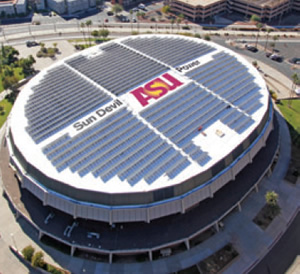Solar-Powered Sun Devils

PHOTO © THOMAS PEREZ, SKYVIEW-HELICAM; COURTESY ARIZONA STATE UNIVERSITY
Passengers flying into Sky Harbor International Airport in Phoenix are greeted with the glimmer from nearly 2,100 solar panels perched atop Wells Fargo Arena. “Sun Devil Power” is emblazoned between the solar arrays. The phrase is a tribute to Arizona State University’s 23.5 megawatts (MWdc) of solar-generation capacity.
ASU began taking advantage of Arizona’s 300-plus sun-filled days per year in 2004 with its initial 34-kilowatt (kWdc) solar photovoltaic installation on the Tempe campus. A decade later, the university is on track to hit 25.1 MWdc by Sept. 2014. The solar strides that ASU makes not only underscore its sustainability commitment, but also are noticed nationally. According to the top ten campuses by total installed capacity list compiled by the Association for the Advancement of Sustainability in Higher Education (AASHE), ASU takes the number-one spot.
“The AASHE recognition reflects our commitment to sustainability,” says Morgan R. Olsen, ASU executive vice president, treasurer and chief financial officer. “But our investment in solar serves additional functional purposes as well. For example, of our 86 solar installations, 49 rooftops are shaded from the intense sun, which helps reduce building energy consumption and extends the life of roofs across our campuses.”
Shading Sun Devils
The importance of shade in the desert Southwest is paramount; the university’s solar installations on its Tempe campus deliver much needed shade to 21 parking lots and a softball stadium.
The Alberta B. Farrington Softball Stadium is the university’s first solar seating canopy that supplies 828 shaded seats for Sun Devil fans.
The PowerParasol™, designed by Strategic Solar Energy, LLC, is a first-of-its-kind solar canopy adjacent to ASU Football’s Sun Devil Stadium.
Four structures harness 2.1 MWdc, stand 24 feet high and shade 852 covered spaces that span 5.25 acres of parking lot. Five additional canopies cover heavily traveled pedestrian areas that provide both green power and attractive outdoor spaces to study and collaborate on campus.
Additional noteworthy solar installations include the SunPower solar farm at the Polytechnic campus, as well as the recently renovated Sun Devil Fitness Complex and the Health Services Building; both on the Tempe campus. Health Services is ASU’s second LEED Platinum facility certified by the U.S. Green Building Council. At approximately 34,000 gross square feet, the building houses 240 solar photovoltaic panels with a peak DC output of 69.3 kWdc.
The Sun Devil Fitness Complex spans 84,500 gross square feet and is the university’s first facility to combine both solar thermal and photovoltaic systems. A 2.1-MWdc solar thermal rooftop system has 6,976 evacuated tubes and provides the building with solar cooling, pool heating and domestic hot water. A 261-kWdc, 869-photovoltaic-panel rooftop system feeds the facility with electricity.
The 1-MWdc SunPower solar farm is the company’s first commercial-scale deployment of its C7 Tracker CPV technology, which concentrates the sun’s power seven times. The installation has 8,640 CPV modules.
Supporting Solar
All of ASU’s solar achievements have been possible through its business partners in the energy and financial sectors. Of its 86 solar systems that span four campuses and the ASU Research Park, ASU owns ten.
ASU purchases all power generated by the remaining systems, which are third-party owned and operated. Solar investments made by third parties total more than $146 million and exclude the SunPower solar farm. Once a system’s third-party agreement expires, ASU has the option to own and operate that solar system.
“Over the past decade, these types of third-party agreements have helped solar energy generation capacity thrive at ASU; both environmentally and economically,” says Bruce Jensen, interim associate vice president, ASU Facilities Development and Management. “With support from our partners, over time, the university experiences a reduced capital investment and hedges against utility cost increases.”
ASU solar installations on the Tempe, West and downtown Phoenix campuses are facilitated, in part, by Arizona Public Service’s (APS) Renewable Energy Incentive Program.
Solar installations on the Polytechnic campus and ASU Research Park are facilitated, in part, by Salt River Project’s (SRP) EarthWise Commercial Energy Incentive program.
Learn more about ASU solar at asusolar.asu.edu.
This article originally appeared in the issue of .